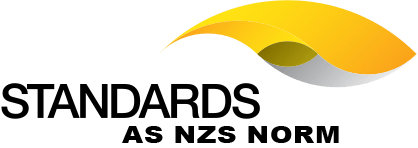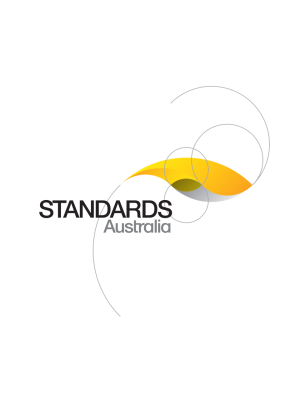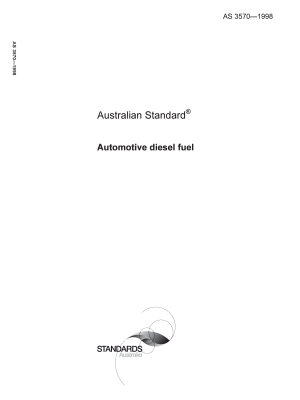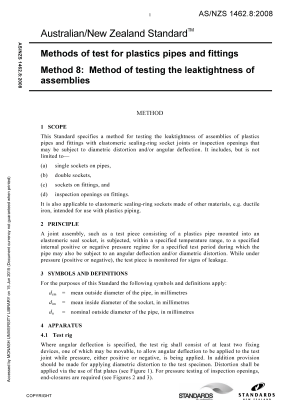🔍

Purchase the full subscription package now and enjoy a 40% discount, along with free updates for future editions.
AS/NZS ISO 19122:2006
$237.16
Geographic information/Geomatics — Qualification and certification of personnel
Adopts ISO/TR 19122:2004 which describes and defines the objectives of the field of Geographic Information/Geomatics.
Table of contents
Header
About this publication
Preface
Introduction
1 Scope
2 Terms and definitions
3 Abbreviated terms
4 Review of existing qualifications and certification systems
4.1 Introduction
4.2 Questionnaire results
4.3 General comments
5 National case studies
5.1 Introduction
5.2 Australia
5.3 Austria
5.4 Canada
5.5 China
5.6 Finland
5.7 Germany
5.8 Japan
5.9 Korea
5.10 Portugal
5.11 Saudi Arabia
5.12 South Africa
5.13 United Kingdom
5.14 United States
5.15 International case studies
5.15.1 International Federation of Surveyors (FIG)
5.15.2 International Hydrographic Organization (IHO)
5.15.3 International Society for Photogrammetry and Remote Sensing (ISPRS)
6 Discussion
6.1 Introduction
6.2 Definitions
6.3 National professional organizations
6.4 Current qualifications and certification initiatives
6.4.1 Introduction
6.4.2 Authorities who confer qualification and certification
6.4.3 Methods for determining required competency
6.4.4 Levels of qualification/certification conferred
6.4.5 Factors used in determining the level of qualification/certification
6.4.6 Mechanisms for granting qualification/certification
6.5 Future directions
7 Recommendations
Annex A
A.1 Definitions
A.1.1 Spatial Information Services
A.1.2 Geomatics
A.1.3 Commentary
A.2 Education and Training
A.2.1 Overview
A.2.2 Competency Standards
A.2.3 Qualifications and Courses
A.2.4 National Professional Associations
A.2.5 Certification
A.2.5.1 Professional recognition
A.2.5.2 Registration of Surveyors
A.2.5.3 Hydrographic Surveying
A.2.6 Summary of the Australian Case Study
A.2.7 Bibliography
A.3 Attachment A to Australian Case Study
A.3.1 Draft National Competency Standards for Spatial Information Services
A.3.1.1 Australian Qualifications Framework Level Descriptors
A.3.1.1.1 Senior Secondary Certificate of Education
A.3.1.1.2 Certificate I
A.3.1.1.3 Certificate II
A.3.1.1.4 Certificate III
A.3.1.1.5 Certificate IV
A.3.1.1.6 Diploma
A.3.1.1.7 Advanced Diploma
A.3.1.1.8 Bachelor Degree
A.3.1.1.9 Graduate Certificate
A.3.1.1.10 Graduate Diploma
A.3.1.1.11 Masters Degree
A.3.1.1.12 Doctoral Degree
Annex B
B.1 Academic Qualification for Geo-Information Science and Technology in Austria
B.1.1 Introduction
B.2 Higher Education in Austria
B.2.1 Post-secondary Courses
B.2.2 Post-secondary Colleges [Akademien]
B.2.3 Institutes of Higher Education
B.2.3.1 Fachhochschule (FH)
B.2.3.2 Universities and Art Colleges
B.2.3.3 Recent developments: Bachelor/Master Programs
B.2.3.4 Post-graduate Education
B.2.3.5 University-like Courses
B.3 GI-related academic fields of study in Austria
B.4 Example GEO-IT at TU Graz: Bachelor in Geomatics Engineering, Master in Geomatics Science
Annex C
C.1 Definitions
C.1.1 List of terms
C.1.2 Commentary
C.2 Education and Training
C.2.1 General structure of educational system
C.2.2 Commentary
C.3 National Professional Associations
C.4 Current Qualifications and Certification Initiatives
C.5 Future Directions
C.6 Summary of the Canadian Case Study
Annex D
Annex E
E.1 Introduction
E.1.1 General Information
E.1.2 Research — Topics
E.2 The General Situation of Geomatics Education in Germany
E.2.1 Traditional and Non-traditional Ways
E.2.2 Current Accreditation and Certification Initiatives
E.2.3 Causes for changes in geomatics education at the university level
E.3 Changes in Curricula
E.3.1 General Remarks
E.3.2 Example of a Curriculum
E.4 Final Remarks
E.5 Acknowledgements
E.6 References
Annex F
F.1 Definitions
F.1.1 General
F.1.2 Commentary
F.2 National Professional Associations
F.3 Current Qualifications and Certification Initiatives
F.3.1 Registering Surveyors by the Geographical Survey Institute
F.3.1.1 Survey Act (Registration of Surveyors and Assistant Surveyors)
F.3.1.2 Survey Act (Qualification for Surveyors)
F.3.1.3 Survey Act (Qualification for Assistant Surveyors)
F.3.2 Voluntary certification
Annex G
G.1 Definitions of GIS
G.2 Commentary
G.3 National Professional Associations
G.4 Current Qualifications and Certification Systems
Annex H
H.1 Accreditation from the National Mapping Institute
H.2 Recognition from the National Engineering Association (Ordem dos Engenheiros)
H.3 Formal courses in the field of Geomatics
H.3.1 Secondary School Level
H.3.2 Bachelor Level
H.3.3 Graduate Level
H.3.4 Master Level
Annex I
I.1 Introduction
I.2 Definitions
I.2.1 Geographical Information Systems (GIS)
I.2.2 Remote Sensing and Aerial Photography
I.2.3 Survey Sciences
I.3 Qualification (Educational Institutions)
I.3.1 Universities
I.3.2 Technical Institutions
I.3.2.1 Technical Inspectors Secondary Institute/Survey Section
I.3.2.2 Military Survey and Geographic Studies Institute
I.3.2.2.1 General
I.3.2.2.2 Foundation Courses
I.3.2.2.3 Advanced Courses
I.3.2.2.4 Specialist Courses
I.3.3 Short Technical Courses
I.3.4 Program-oriented Technical Courses
I.4 Licensure
I.5 Societies and Committees
I.6 Major Acting Organizations/Influential Entities
I.7 Looking Ahead
I.8 Conclusion
Annex J
J.1 Definitions used in South Africa
J.2 The use of the terms geomatics, geoinformatics and geo-information in South Africa
J.3 National Professional Associations
J.3.1 Surveying
J.3.2 Geo-information interest groups
J.3.3 Society for South African Geographers
J.4 Education and training
J.4.1 The National Qualifications Framework
J.4.2 Existing training programmes in surveying, geoinformation and GIS
J.5 Current initiatives relating to qualification and certification
J.5.1 Summary and concluding remarks
J.5.2 Acknowledgements
Annex K
K.1 Introduction
K.2 AGI — Position on Professional Development
K.3 An Industry Structure Model for the GI Sector
K.4 The AGI Continuous Professional Development (CPD) scheme
K.5 AGI Awards Scheme
K.6 Government and Higher Education
K.7 GI-related Academic Courses within the UK
K.8 GI teaching in Schools within the UK
K.9 Position of Employers and Entrepreneurs
K.10 Cultural Issues
K.11 GI as Part of the Information Technology Sector
K.12 Summary
K.13 AGI Bibliography
K.14 Papers presented at AGI Conferences
K.15 Appendix A to UK Case Study
K.15.1 The Association for Geographic Information (AGI)
K.15.2 Background to this document
K.16 Appendix B to UK Case Study
K.16.1 AGI definitions
K.17 Appendix C to UK Case Study
K.17.1 Universities offering GI-related courses
K.17.1.1 List of universities
K.17.1.2 GI Course Titles
K.17.1.3 GI Application Course Titles
K.17.2 Faculty producing and offering the above titled courses
K.18 Appendix D to UK Case Study
K.18.1 Industry Models
K.18.1.1 British Computer Society (BCS) Industry Model Release 2
K.18.2 The AGI Industry Model – Release 1
Annex L
L.1 Definitions
L.2 Professional Organizations
L.3 Current Qualification and Certification Initiatives1)
L.3.1 Introduction
L.3.2 Certificates for Completion of Software Training
L.3.3 GIS Certification in Higher Education Institutions
L.3.4 Initiatives of Professional Organizations
L.3.5 Conclusion
L.4 Commentary
L.4.1 Issues relating to Survey Practice Laws and the GIS profession2)
L.4.2 States’ Perspectives on GIS and Professional Certification3)
L.4.2.1 Existing Laws Relating to Survey Practice Law and Land Records Law
L.4.2.2 GIS Boards, Surveyor Boards, and Discourse
L.4.2.3 Perception of GIS Certification
L.4.2.4 Guidance on the GIS Certification Issue from States
L.4.3 Certification in the USA, An Ongoing Discussion4)
L.5 Summary
L.5.1 References
L.5.2 Contributors
Annex M
M.1 Summary
M.2 Introduction
M.3 The Nature of Mutual Recognition
M.4 Why is it Important?
M.5 How Does it Work?
M.6 Advantages of Regulatory Disciplines
M.7 The FIG Approach
M.8 A Methodology to Assess Professional Competence
M.8.1 General
M.8.2 The pre-conditions for managing this process of mutual recognition are as follows:
M.9 Surveying Activities and Surveying Professions
M.10 Professional Competence
M.11 The Role of Professional Organizations
M.12 Barriers and Hurdles to Implementation
M.13 FIG Policy Statement
M.14 Final Remarks
M.15 References
M.16 Biographical Notes:
M.17 APPENDIX to FIG Position Paper
Bibliography
Cited references in this standard
Please select a variation to view its description.
| Published | 20/02/2006 |
|---|---|
| Pages | 99 |
Please select a variation to view its pdf.




